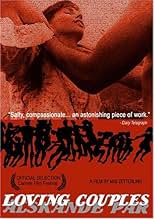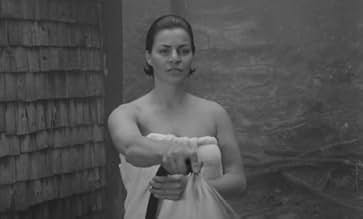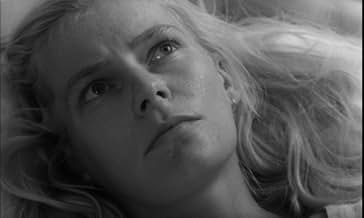- Premios
- 1 nominación en total
Jan-Erik Lindqvist
- Peter von Pahlen
- (as Jan-Eric Lindquist)
- Dirección
- Guionistas
- Todo el elenco y el equipo
- Producción, taquilla y más en IMDbPro
Opiniones destacadas
It's a wonderful film although certainly a rather cynical view of marriage and love, evidently in Sweden in 1914, or maybe somewhere else and a later time. The ladies, Alda, Adela and Angela played by Harriet Anderson, Gunnel Lindalom and Gio Petre absolutely splendidly. At the beginning there are the three in the stark hospital and all each expecting a child. There are three rather different stories and we have flashbacks of them so the slow and rather sad beginning really gets going with a lot of fun and sex and surprises all the time. There is nudity and passionate scenes that it is rather surprising for the early 60s and caused a problem in many countries. The cinematography is fantastic by Sven Nykvist like the shots in the woods and with the frolicking and much drinking during the midsummer celebration and also in the fantastic pretend marriage with two gays and the sublime Anderson.
There is no doubt that the Swedish actress Mai Zetterling, in her feature-length directing debut, had Ingmar Bergman in her mind: the cast is full of Bergman veterans, the cinematography is by the emblematic Bergman collaborator Sven Nykvist, and the whole style of the movie is modelled on her famous compatriot. Technically, the imitation is accurate: the film is well-made, the acting is fine, and I liked how Zetterling contrasted three different types of women - one happy all the time, one never happy, one somewhere in between. But the stories are too long and meandering, and for a movie so heavily dependent on flashbacks (about 80% of the running time), the flashbacks themselves are not especially revealing. **1/2 out of 4.
Both in the ambiance and in its women's themes in this movie you can see unequivocally Bergman's influences. In particular It recalls Bergman's SECRETS OF WOMEN (1952)for the cast ( It's almost the same!)and for its episodic structure. The psychological search on women universe is another important link.
Anyway, although Mai Zetterling had abused it in her movies, I think that the flashback use is very interesting in this movie. It becomes, with the editing help, a concrete tragic matter and not only a way to tell the story. I give it a 6.
Anyway, although Mai Zetterling had abused it in her movies, I think that the flashback use is very interesting in this movie. It becomes, with the editing help, a concrete tragic matter and not only a way to tell the story. I give it a 6.
Comparisons to Bergman are inevitable as there are many similarities - the themes (resembling those in Brink of Life and Smiles of a Summer Night), cast (Harriet Andersson, Gunnar Björnstrand, and Eva Dahlbeck), and even cinematographer (the immortal Sven Nykvist). However, Mai Zetterling makes this film her own, showing a distinctly female point of view in this story of three women about to give birth at a hospital. We see misogyny in the various patriarchal figures, one of whom is a pedophile, but we see that even in a male-dominated world, women are empowered in their sexuality. This includes lesbian attraction, romps in the woods, becoming pregnant out of wedlock, and marrying a gay man to conceal the true father. It's pretty daring stuff for 1964. The real theme seems to be to show "loving couples" as they actually are, and how the world works behind a veneer of respectability.
The film is extremely strong in its first half with some gorgeous scenes outdoors, including a flashback to a funeral in a stunning birch forest, and a walk through flowering orchards at a girl's boarding school. They provide quite a contrast to the scenes in the hospital, with those squeaky gurney wheels rattling down halls that "look like prison" as a doctor puts it, and images looking up from the patient's perspective. Through flashbacks we gradually come to understand the three women's stories, and how their lives intersect, but unfortunately the plot unravels a bit as it plays out, getting messy and harder to follow than it should have been. It's a very good film, one with lots of beautiful moments and one I enjoyed, but could have been even better with stronger storytelling.
The film is extremely strong in its first half with some gorgeous scenes outdoors, including a flashback to a funeral in a stunning birch forest, and a walk through flowering orchards at a girl's boarding school. They provide quite a contrast to the scenes in the hospital, with those squeaky gurney wheels rattling down halls that "look like prison" as a doctor puts it, and images looking up from the patient's perspective. Through flashbacks we gradually come to understand the three women's stories, and how their lives intersect, but unfortunately the plot unravels a bit as it plays out, getting messy and harder to follow than it should have been. It's a very good film, one with lots of beautiful moments and one I enjoyed, but could have been even better with stronger storytelling.
Three women at a lying-in hospital reflect on how they got there in Mai Zetterling's first feature as a director.
I was surprised at how Bergmanesque this movie was, although not as overtly cerebral. Of course a good deal of that can be attributed to the presence of Harriet Anderson, one of Bergman's frequent leading ladies, and Sven Nyquist being the cinematographer; but while it looks like a duck and walks like a duck, it doesn't quack like a duck. Instead of Bergman's meditation on keeping society going in a G*dless universe, it considers woman's place in a society run for the benefit and pleasure of its men; and the continuation of society depends more on popping out babies, a process which the women don't have on their minds when they get pregnant. Bergman may mourn the absence of G*d, but to Zetterling, He's irrelevant.
I was surprised at how Bergmanesque this movie was, although not as overtly cerebral. Of course a good deal of that can be attributed to the presence of Harriet Anderson, one of Bergman's frequent leading ladies, and Sven Nyquist being the cinematographer; but while it looks like a duck and walks like a duck, it doesn't quack like a duck. Instead of Bergman's meditation on keeping society going in a G*dless universe, it considers woman's place in a society run for the benefit and pleasure of its men; and the continuation of society depends more on popping out babies, a process which the women don't have on their minds when they get pregnant. Bergman may mourn the absence of G*d, but to Zetterling, He's irrelevant.
¿Sabías que…?
- TriviaMai Zetterling's directorial debut.
- Citas
Dr. Jacob Lewin: I can't do much unless you take your pants off and lie down.
- ConexionesFeatured in Vielleicht bin ich wirklich eine Zauberin (1989)
- Bandas sonorasBagni di Lucca
Composed by Giuseppe Manente (1903)
Selecciones populares
Inicia sesión para calificar y agrega a la lista de videos para obtener recomendaciones personalizadas
- How long is Loving Couples?Con tecnología de Alexa
Detalles
- Tiempo de ejecución1 hora 58 minutos
- Color
- Mezcla de sonido
- Relación de aspecto
- 1.66 : 1
Contribuir a esta página
Sugiere una edición o agrega el contenido que falta

Principales brechas de datos
By what name was Älskande par (1964) officially released in India in English?
Responda




































